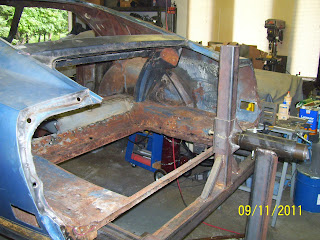The last major structural repairs that must be completed on my Boss 302 before “regular” restoration work can commence involve replacement of the trunk floors, rear tail light panel, rear quarter extensions and repair of the front trunk floor/axle tunnel flanges along with a small amount of rust repair on the right rear wheel arch.
It sounds so simple to condense it down that way, but this amount of work is quite extensive and will take a few months to complete, if not longer. In fact, as the pace of restoration work has slowed over the last few weeks with non-Boss related activities, the chances are that this particular project will continue deep into the winter before it is complete…….so let’s get started!
At one point, before my ownership, this car was the “meat” in a traffic accident sandwich and suffered light damage to the rear and somewhat heavier damage to the front sheet metal. Luckily, the rear quarters were not buckled in the incident, but the tail light panel, and rear center trunk floor and lower valence were folded noticeably and the temporary repairs were very poorly executed. The end result was rust invasion between every panel such that the only way for me to repair them was total panel replacement.
I spent several weeks studying the landscape of this repair, carefully mapping out every step I would take in making sure the end result would be well-fitting, straight and pristine sheet metal. Once I was comfortable with where I was going, and the repair panels were in hand, I was off to the races.
One significant change to my plans was actually a welcome reduction in the scope of work I had envisioned. The lower rear section of the right quarter panel was where the rust repairs were required. Originally, I planned to install a complete patch panel along the entire lower rear quarter panel section, however on closer examination, I discovered I had a lot of good metal around the area and the repair could be condensed to a small patched area instead. This leaves the vast majority of the original quarter panel completely intact which is a bonus by almost any definition. The one caveat to this repair is that it will have to be done while I have the right side trunk floor out to allow proper access to the back side of the repair areas. No biggie, just planning.
With a solid plan in place, I pulled out my trusty red paint pen and set off marking the cut lines that would allow me to efficiently remove the bulk of damaged sheet metal in the shortest time. Next, I squared and leveled the chassis on the rotisserie and placed my jacking posts under each rear torque box to maintain this position and to provide substantial support to the chassis while the repairs were being made.
Using a white paint pen, I started marking the spot weld locations that would need to be drilled to allow the fender extensions and inner jack mount, spare tire mount and rear bumper brackets to be removed. Then out came the “screaming wheel of death” and the sparks started to fly! After about a half hour and three cutoff blades, I had the tail light panel out of the car.
With room to work, I could now drill the spot welds and remove the jack and spare tire mounts, both rear bumper brackets and both rear fender extensions with relatively little trouble. This also allowed me plenty of room to scrape the little bit of remaining undercoating off the inner rear quarter panels to make all future work even easier as well as provide a nice smooth surface for Dynamat adhesion when the finish work begins.
I cleaned up and straightened the fender extension flanges with a little angle grinder work and some hammer and dolly taps and began fitting the fender extensions using the factory body locating holes in each quarter panel flange. I was pleasantly surprised at how well the fender extensions fit (for a change) and I like the one-piece design of the new panels over the rust prone 2-piece design of the original extensions. Of course, restoration purists will throw up all over this idea, but from a practical perspective, the idea is a good one and I am glad for it in my case.
I spent quite a bit of time making sure the fit of the new quarter extensions was as good as it could be and clamped them in place just as if they were being installed. Then I carefully marked each spot weld location so I could remove the e-coat only where the welds would be needed. Did I mention you can never have enough good vise-grip style welding c-clamps?



















Sven, I continue to be impressed by the quality of your work. You will have one stunning Boss when you're done.
ReplyDeleteThanks Dennis!
ReplyDeleteExcellent job. Can't wait to see the rest.
ReplyDeleteThanks Alex! I'm thinking there's another sand blasting day in my near future to save time and do a better job on the intricate stuff so I can get on with more fun work. Hate the thought, but the weather is just too darn good! Rats!
ReplyDeleteGotta agree with your comment on the number of clamps there... the only time you have too many is when there is one lying on the floor
ReplyDeleteAmen Mike! I am actually thinking about grabbing a few more for this trunk floor job for good measure!
ReplyDelete